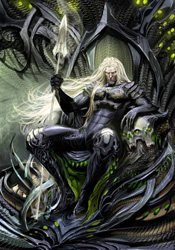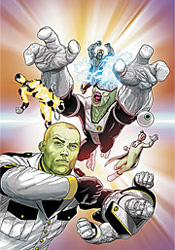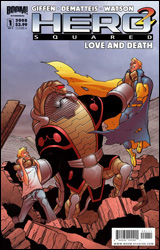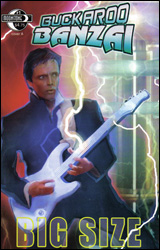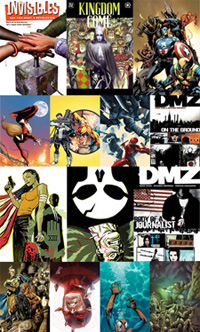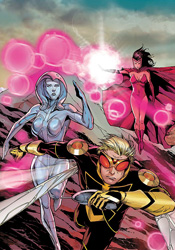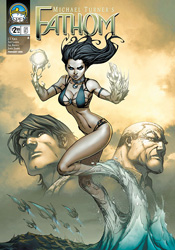A quick glimpse at what else I've been reading this month...
Invisibles Volume 1: Say You Want a Revolution - I love Grant Morrison when he's on, and the first story arc here is some solid stuff, even if it's begun to show its age. I went in without any idea what to expect or what to think, and enjoyed where it took me. The adventures of a juvenile delinquent with a mad homeless guy on drugs in another reality is something you'll only find published by Vertigo. The second arc lost me a bit, mostly because I'm not all that crazy about comics that involve real historical figures and spend too much time wallowing in prose, both of which were featured in a major way. While I'd thought I was close to understanding the big picture after the first arc, the second threw me for a loop and left me questioning whether I'm really interested in continuing the series. I felt that Jill Thompson's artwork was a horrible mismatch. She was terrific on
Sandman and has gone on to a fine career, but the light nature of her work didn't provide a good partner for Morrison's dark-hinted, deviant-themed storytelling.
6/10Kingdom Come: Book One - I was inspired to go back and reread this entire series after reviewing an episode of
The Kingdom in December. Still a very good read, although not quite as good as I'd remembered it being. Alex Ross's artwork benefits from a foggy memory and doesn't stand up as well as I'd thought, although it's unquestionably some of the finest work of his career. Still, the issue delivers when it wants to with huge reveals and emotional turns. Superman's big moment at the end of the issue is a fine cliffhanger, and the incident in Kansas was treated extraordinarily well. Better still, I know the best moments are yet to come. I received a whole armload of TPBs for Christmas, though, so I'll have to leave issues 2, 3 and 4 on the backburner for now.
8/10New Avengers #48 - Kind of a nothing issue for me, picking up the pieces of
Secret Invasion (because really, 30 dedicated issues of
New Avengers wasn't enough of a focus on the Skrulls) and following the abduction of Cage and Jessica's baby, which is a plot thread I really don't give two craps about. Billy Tan's artwork was genuinely terrible from cover to cover, stealing the flexibility and personality from Spider-Man, turning Wolverine into a 500-pounder, making the new Cap look even stiffer than usual and putting Osborn's head on the body of an American Gladiator. Bendis gave Logan a great line though, offering a drink to Iron Fist. "My body is a temple." "Then put beer in your temple." Sadly, that line alone wasn't worth $2.99.
3/10Ultimate Spider-Man #129 - I guess if they're discontinuing
Ultimate Fantastic Four, Bendis plans to keep Johnny Storm active in this series? A few interesting turns that should be fun to see play out, like Johnny's crush on Parker's female clone... can't wait to see how that one goes. Mostly a character issue, with about three frames of Peter in his Spidey threads and four pages of action, but that's par for the course as far as
USM goes. Immonen's work has begun to slide of late, and he looks strangely Bagley-esque here. I like the cliffhanger the issue ended with, but I have a feeling
Ultimatum's tidal wave is going to hit NYC in time to ruin that storyline before it gets moving. Not the best issue, but worthwhile anyway.
6/10New Punisher #1 - I actually loved this, despite getting all kinds of bad vibes from the cheesy cover and the hilariously bad premise of sniping someone with a six-foot long rifle from four miles away. Rick Remender just took Frank and the Sentry, gave them a reason to be angry with each other and let the characters dictate the rest of the action. Basically just a popcorn-chomping action story that explores what would happen if the Punisher and Superman ever faced off, with the end result something of a draw. Dozens of awesome moments, the best of which would have to be Castle opening fire six inches away from the Sentry's face while being carried through the open sky. Jerome Opena's artwork is great, too, a tight mix of Sam Kieth and Leinil Francis Yu.
8/10Daredevil #114 - When it's on track, this is my favorite book on the market. Every time I think Matt's reached rock bottom, something new happens to remind me I don't even know what the term means. Sharp, smart dialog, a lights-out supporting cast, fresh new faces every month that fit perfectly into the tapestry and risks aplenty. I don't really care for Lady Bullseye, but that's OK because she didn't even show up this month. Hooray! This is fantastic writing, and the artwork is a perfect match. Lovin' it.
10/10DMZ Volume 1: On the Ground - I'd never had an opportunity to check this series out until I was assigned an issue earlier in 2008 and am now making up for lost time. An imaginative, well-planned premise, a glimpse into civilization that's sometimes a little too honest, and an explosion around every corner. It's very smart at its core but still manages a thrill a minute, mixing bits and pieces of cinema's best apocalyptic visions of the near-future and military action, like
I am Legend meets
Black Hawk Down. Although the book's political motivations are clear, Brian Wood does give the impression that he's trying to split the narrative evenly between both perspectives, and does at least fleetingly acknowledge that nobody ever believes they're on the "evil" side in this kind of a situation. Paired with Riccardo Burchielli, a high quality artist who only seems to get better as the series continues, this is great reading. As introductions go, I call it top notch. Three fantastic voyages in just five issues, damn.
10/10DMZ Volume 2: Body of a Journalist - The first really involved story arc of the series, I loved it to pieces. By the end of the trade, Matty has been in NYC for over a year and he's grown tremendously as a character. Things never went in a direction I could've predicted, but in retrospect everything made perfect sense. My only qualms were with Zee's origin issue and the handbook that closed the issue, neither had the appeal or matched the intensity of the primary story... they just felt kind of tacked on.
9/10Punisher: Frank Castle #66 - I thought the last storyline / writer started off hot and quickly cooled as things played out, but this new team hasn't caught my interest at all. Well, scratch that - I have some mild curiosity about the cliffhanger at the end of the issue, but it's so hard to convince readers that the lead character of three separate ongoing titles is in real trouble, a lot of the edge is lost before the arc even gets off the ground. Also, why does every single story involving Frank have to start with the same setup? We get that he kills a lot of mobsters. It's kind of redundant by this point. I'm thinking about removing this from my pull folder.
3/10100 Bullets #99 - Can't believe this series is almost over. I'm still hopelessly lost as to where the story's going, but the artwork is as strong as ever and people are dying left and right so I can't want for consequence. I really need to go back and re-read the entire series so I'm somewhat aware of what's going on in time for the finale.
7/10New Avengers #49 - Well, at least that storyline didn't linger. This read like a quick blowoff that trivialized the only interesting development from last month's issue (Luke switching sides) and reset the status quo on a whim. But whatever, at least now we don't have to deal with a sixteen-issue arc about chasing an alien-abducted baby. Feels like it's been five years since the Civil War, but we're only just now getting the promise of a real face-off between the dueling Avenger squads (naturally, the very second one roster completely changes), but I don't know if I buy Hawkeye's reasoning as much as his teammates did. A very mediocre showing from Bendis meets artwork of a similar level from the blase Billy Tan.
5/10Daredevil #115 - I love the Izo character, and can't wait to see his relationship with both Murdock and Iron Fist evolve over the next few months before he's unceremoniously slaughtered before their very eyes by the next big threat. Still don't see a lot of promise in Lady Bullseye, but it's becoming clear that she's little more than a pawn in the grand scheme anyway. I was ready to cheer aloud when Matt pulled down his mask to REALLY join the battle in the middle of this issue, but then all the fighting stopped and it was time to talk for a while. Laughed my ass off at the message of that talk, too ("The Hand doesn't take no for an answer!" "I understand, but my answer is still no." "Oh... well, no big deal. See you later then!") , but I don't think that's what Brubaker was going for. A bit of a slowdown following the chaos of last month's issue, but still a fine read. I didn't think much of the Hand's "Plan B" comment until I turned the page and saw the cover for next month. If that means what I think it means, shit...
8/10Ultimate Spider-Man #130 - After a few months of subpar contributions, the real Stuart Immonen is back! His work on the countless splash pages that coated this issue was phenomenal, particularly the shots of the grounded ship in the middle of NYC and the Hulk confronting Spidey at the end of the issue. Simply gorgeous. It's a shame this was slammed right into the middle of
Ultimatum, because it made actually reading it a bit disorienting. When we left them last month, Pete and friends were headed downtown to party with Johnny Storm. From the outset this month, his buddies are busy rescuing civilians from a communter train and Parker's in full wardrobe swinging through the city without so much as an editor's note. Surely that could've been done a bit more smoothly...?
7/10Wolverine #69: Old Man Logan - The gimmick is starting to wear a little thin at this point, and I don't know if I can live with a book that ships twice a year. Naturally, this issue came out in November so I'm a little behind, but it's taken that long for a copy to remain on the shelves long enough for me to actually buy it. McNiven's artwork varies from breathtaking to sloppy, and Millar's story follows suit. The cool stuff is really cool (Loki's enormous skeleton crushed beneath the Baxter Building) but the boring stuff balances things out by being really boring. I loved this series after the first two issues, but my patience is wearing thin.
5/10
